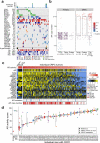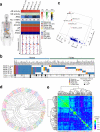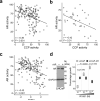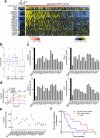Substantial interindividual and limited intraindividual genomic diversity among tumors from men with metastatic prostate cancer
- PMID: 26928463
- PMCID: PMC5045679
- DOI: 10.1038/nm.4053
Substantial interindividual and limited intraindividual genomic diversity among tumors from men with metastatic prostate cancer
Abstract
Tumor heterogeneity may reduce the efficacy of molecularly guided systemic therapy for cancers that have metastasized. To determine whether the genomic alterations in a single metastasis provide a reasonable assessment of the major oncogenic drivers of other dispersed metastases in an individual, we analyzed multiple tumors from men with disseminated prostate cancer through whole-exome sequencing, array comparative genomic hybridization (CGH) and RNA transcript profiling, and we compared the genomic diversity within and between individuals. In contrast to the substantial heterogeneity between men, there was limited diversity among metastases within an individual. The number of somatic mutations, the burden of genomic copy number alterations and aberrations in known oncogenic drivers were all highly concordant, as were metrics of androgen receptor (AR) activity and cell cycle activity. AR activity was inversely associated with cell proliferation, whereas the expression of Fanconi anemia (FA)-complex genes was correlated with elevated cell cycle progression, expression of the E2F transcription factor 1 (E2F1) and loss of retinoblastoma 1 (RB1). Men with somatic aberrations in FA-complex genes or in ATM serine/threonine kinase (ATM) exhibited significantly longer treatment-response durations to carboplatin than did men without defects in genes encoding DNA-repair proteins. Collectively, these data indicate that although exceptions exist, evaluating a single metastasis provides a reasonable assessment of the major oncogenic driver alterations that are present in disseminated tumors within an individual, and thus may be useful for selecting treatments on the basis of predicted molecular vulnerabilities.
Figures






References
-
- National Research Council (U.S.) Toward precision medicine : building a knowledge network for biomedical research and a new taxonomy of disease. National Academies Press; Washington, D.C.: 2011. Committee on A Framework for Developing a New Taxonomy of Disease. - PubMed
-
- Perou CM, et al. Molecular portraits of human breast tumours. Nature. 2000;406:747–752. - PubMed
-
- Sato Y, et al. Integrated molecular analysis of clear-cell renal cell carcinoma. Nat Genet. 2013;45:860–867. - PubMed
Publication types
MeSH terms
Substances
Grants and funding
LinkOut - more resources
Full Text Sources
Other Literature Sources
Medical
Molecular Biology Databases
Research Materials
Miscellaneous

